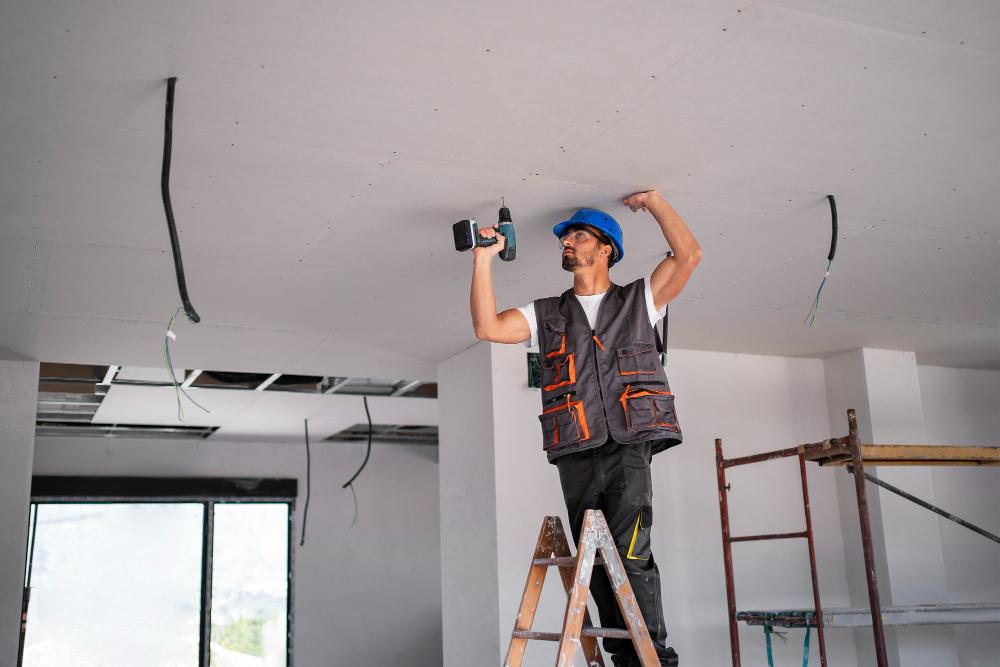The ceiling is the "fifth wall," and the roof is the shield of the home. When there are cracks, moisture stains, echoes between rooms, or noise from neighbors, the problem is not just aesthetic: you are losing energy, comfort, and property value. In this guide, you will see when and how to act: soundproofing the ceiling, acoustic insulation of the ceiling, proper preparation (ceiling plaster), and when it is reasonable to install drywall on the ceiling (including the installation of a suspended drywall ceiling).

When is it time to think about soundproofing/sound insulation
• Noise from above/neighbors: heavy footsteps, furniture, music. Look for solutions with elastic profiles, mineral wool, and double cladding — focus on soundproofing ceiling neighbors.
• Echo in the room: in empty spaces, high ceilings, and hard surfaces. Additional cladding and acoustic panels solve the problem..
• Cold "winter" rooms: if the ceiling borders an unheated attic space/roof, sound insulation of the ceiling with insulation provides a thermal effect as well..
💡Advice: To receive accurate quotes, take pictures of the problem areas and describe when the noise is the loudest. Detailed requests provide more realistic timelines and prices — see also How to order a service on Ofertirai.me?

Is the suspended ceiling a "major renovation"?
Not always. Installing a suspended ceiling made of drywall allows you to hide imperfections, cables, spots, and insulation in one operation. In combination with mineral wool, you gain silence and a more even temperature. In complex geometries or attic spaces, it is time to install drywall on the ceiling with separate zones for insulation and access panels.
When to think about the roof
Stains and odors of moisture often "arrive" from above. Check the waterproofing and the details of the drywall installation on a sloped roof (if there is one): before finishing the ceiling, the roof must be sound; otherwise, you risk recurring damage.
Мазилка, шпакловка и финиш: защо са важни
Even the best insulation won't look good without a quality finish. Ceiling plasters and proper ceiling coating provide a smooth surface, free of "orange peel," cracks, and shadows. Mistakes often become apparent when the spots are first turned on—so take your time and request trial lighting to inspect for defects.

How much does it cost and what does it depend on
The topic "ceiling soundproofing prices" most often depends on:
• area and thickness/type of insulation;
• single-layer or double-layer drywall sheathing;
• complexity (niches, lighting, slopes), accessibility, and height;
• need for corrections to the roof/ceilings before cladding;
• finish volume (putty, ceiling plaster, paint).
📌 Tip: compare offers based on scope (materials/layers), timeline, warranty, and whether a clean finish is included. For a structured approach, see 10 important questions to ask the contractor before the project begins..
Common mistakes (and how to avoid them)
• Foam instead of a system: insulation is not just about "putting something in." Proper profiles, insulation, strips, cladding, and details around installations are needed.
• Without inspection openings: after every minor check, it becomes "repair."
• Skipping the primer/putty: the paint does not hide defects, but rather highlights them.
• Lack of expansion joints: cracks after months.
• No inspection with light on the slope: on slopes, all irregularities "scream" under the spotlight.
Quick action plan
1. Take pictures of the ceiling/issues (stains, cracks, cables).
2. Describe the source of noise/moisture and the time when it occurs.
3. Specify the purpose: soundproofing the ceiling, leveling, hiding the lighting, or everything together.
4. Send the same specification to 2–3 verified teams.
5. Choose an offer with clearly described layers, materials, finish, and warranty.
Conclusion
Properly executed roofs and ceilings bring silence, warmth, and a "finished" home. Gather personalized offers, compare scope and warranty, and rely on verified specialists — the effect is felt every day.